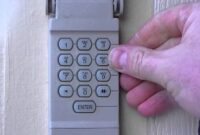Contents
PLL Garage Doors and Gates – Microprocessor Controlled Garage Doors and Gates GarageDoorSalesNearme.Com | A Microprocessor controlled garage door operator is the ultimate solution for the most complex automatic gates.
The following are some tips that will make your door operation go as smoothly as possible. Read on to learn more about these technologies.
This article also covers other topics you should know about: Up force, Photo eye sensors, Alarm response logic, and Microprocessor controls.
Listed below are some of the best features of these technologies. If you want to automate your gates at home, you should invest in these products.
PLL Garage Doors and Gates
#Up force
To test the Up force of garage doors and gates, place a full roll of towels at the center of the door and push the towel toward the door.
If there’s not enough force, try lowering the towel to 5 feet below the center. The door should reverse automatically when the towel reaches the door’s path.
If the roll of towels isn’t moving, contact a garage door contractor. In some cases, it may be difficult to measure the Up force on your own.
#Photo Eye Sensors
If you’ve been using a pll garage door or gate for years and have had no problem with them, there’s a good chance that you’ve noticed that the photo eyes have been malfunctioning.
This could be due to a number of reasons, including dirt or debris that is blocking the beam, or the sensors themselves being out of alignment.
To fix this issue, simply loosen the wing nuts on each sensor, and move it into place. If this doesn’t solve the problem, you can try cleaning the sensors manually. The last possibility is that the sensors aren’t properly aligned.
If the beam is broken, the sensor will note this and break the circuit. When this happens, the door will remain closed until the beam is restored.
To resolve this problem, you should first inspect the garage door. Check for debris and blockages, and then replace the damaged sensor.
Otherwise, you may have to replace the entire unit. You can also replace the photo eye sensors as needed. A broken connection may also cause the door to reverse.
A malfunctioning photo eye sensor is a major safety concern for your garage door. This safety device helps make sure that the door opens and closes without obstacles, preventing safety risks and keeping your garage in good working order.
For example, the photo eye sensor on a pll garage door can prevent a fall if something falls on it. Therefore, this system is a must have for your garage door.
Fortunately, photo eye sensors are available on new models of garage doors and gates. This new technology has made it easy to install.
It’s not difficult to install, but older models aren’t likely to be retrofitted with photo eye sensors. The newer models are safer and more energy efficient, and will operate much smoother. If you’re using an old garage door opener, photo eye sensors might be incompatible with your opener.
PLL Garage Doors and Gates
#Microprocessor controlled garage door operator
A microprocessor-controlled garage door operator eliminates the need for upper and lower limit switches. It stores these limits in memory and sets them a small amount higher than the actual force required to raise and lower the door.
A security switch connected to the microprocessor of the door operator prevents unauthorized access by requiring a specific code to operate the system. This system is a highly efficient and convenient alternative to a manual opener.
A microprocessor-controlled garage door operator is designed to operate sectional garage doors. Its compact design allows for installation in any environment, and features a wide selection of chain rails.
The head unit, which consists of a motor, is integrated into the rail, while the limit switch and encoder are located in the operator. SMART models come with an exclusive anti-intruder function.
It also contains two program force flags, one for up and one for down. When the SYSC flag is active, the up force flag is set and the down force flag is reset.
In the up direction, the up limit is programmed, while the down limit is programmed in the down direction. When the PFD flag is active, the door will run from up to down.
The CLC switch adds a value to the register pairs to program the down force. Then, when the door is in the down position, it will push harder into the floor.
This prevents the door from accidentally closing. If the door has been programmed with limits that exceed the threshold set, the CLC switch will stop the door in its tracks. This feature is essential to prevent the door from being stuck.
One of the most popular features of the Garadget is a built-in geofencing feature. Its built-in geofencing feature makes it a great option for single-door operations.
It also offers good sharing options, voice notifications, and a built-in sensor for older Chamberlain models. Lastly, it is compatible with IFTTT and Alexa.
#Alarm response logic
A typical example of alarm response logic for a pll garage door or gate is an XOR gate. The logic is designed to determine if a change in the environment is an alarm.
In response, it may stop movement. The XOR gate could also be set to operate only when an object is detected near the first antenna. This is particularly helpful if a person or vehicle is attempting to enter the garage without the door being closed.
This circuit can detect small changes in the environment and activate alarms based on the change. For example, the circuit uses two antennas connected to the lower portion of the garage door.
The circuit also employs pulse generation logic using the capacitance of the antennas and resistors. A single PLL can be used in a novel amplifier configuration to detect small changes in a door or gate. Alarm response logic is an important component in any door or gate.
To prevent false alarms, the threshold of the alarm signal can be set at 75 decibels or one minute. The threshold can be higher or lower to prevent false alarms.
A second feature of this alarm response logic is selective discrimination. It may detect a sound of an object that is only an inch or two above the floor.
It may even determine whether or not an object is approaching or moving. This is especially useful for gates and garage doors with multiple levels.
Another important component of an alarm response logic for pll garage doors and gates is radar logic. This allows the door to be stopped if an object approaches it.
If the object is moving too fast, the door may stop while moving downward, causing it to hang or drag. Therefore, it is important to consider the risks of opening the garage door without an object. The door may also become stuck underneath an object that is not meant to move.
An example of alarm response logic for a pll garage door or gate can be shown in FIG. 8. This method includes an antenna that is mounted on the bottom edge of the garage door and a motion detector.
The garage door may move up and down a track. The antennas are connected to an alarm logic 14 by wires. An alarm condition is present if the difference is greater than the previous pulse.



